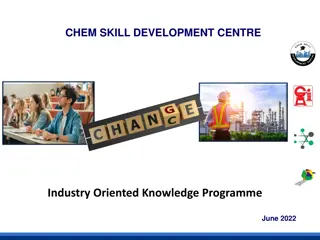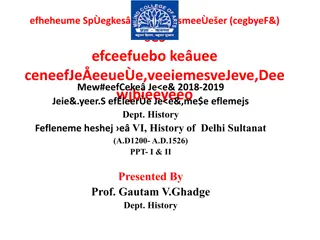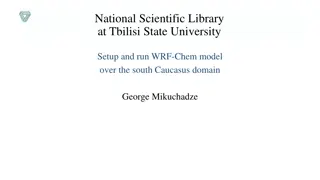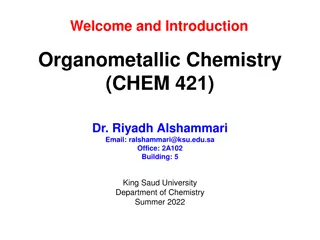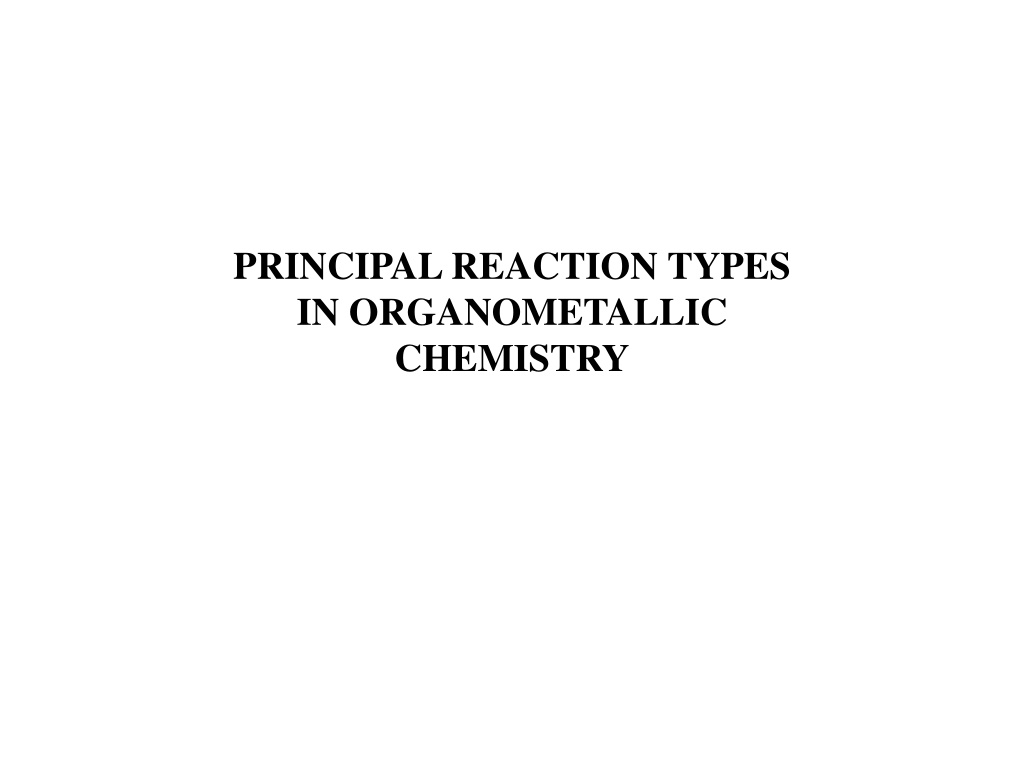
Reaction Types in Organometallic Chemistry
Explore the principal reaction types in organometallic chemistry, including salt elimination, protonolysis, migratory insertion reactions, elimination reactions, ligand substitution reactions, transmetallation, oxidative addition, and reductive elimination. Learn how these reactions occur with examples and applications in homogeneous catalysis.
Download Presentation

Please find below an Image/Link to download the presentation.
The content on the website is provided AS IS for your information and personal use only. It may not be sold, licensed, or shared on other websites without obtaining consent from the author. If you encounter any issues during the download, it is possible that the publisher has removed the file from their server.
You are allowed to download the files provided on this website for personal or commercial use, subject to the condition that they are used lawfully. All files are the property of their respective owners.
The content on the website is provided AS IS for your information and personal use only. It may not be sold, licensed, or shared on other websites without obtaining consent from the author.
E N D
Presentation Transcript
PRINCIPAL REACTION TYPES IN ORGANOMETALLIC CHEMISTRY
1. Salt Elimination (often known as salt metathesis): Salt metathesis is a chemical reaction in which one part of each two compounds interchange to form two new compounds M-Cl + Li-R M-R + LiCl Metal halide + group 1 alkyl soluble insoluble in organic solvent M-Cl + RMgCl M-R + MgCl2 2. Protonolysis: Protonolysis is the cleavage of a chemical bond by acids M-R + HX M-X + H-R
3. Migratory Insertion Reactions: Migratory insertion is very important reaction, which occurs in homogeneous catalysis. It is used to form C C and C-N bonds.
4. Elimination reactions: a) -Hydride elimination This reaction includes the transfer of hydride from -position on a ligand to the metal center, which involves a formal oxidation of the metal. b) -Hydride elimination This is the most common way for a metal alkyl to decompose.
5. Ligand substitution reaction: a) Ligand addition (association) reaction This reaction occurs when the metal center has one or more empty orbital to accommodate incoming ligand.
b) Ligand dissociation reaction This type of reaction involves in releasing a ligand from the compound. The dissociation of the ligand depends on how strongly or weakly it is coordinated to the metal center and steric effects. 6. Transmetallation: This reaction involves the transfer of ligands from one metal to another. M + M'R MR + M'
7. Oxidative Addition (O. A.): Oxidative addition (OA) is a process that adds two anionic ligands e. g. A and B, that originally are a part of a A-B molecule, like in H2or Me I, on to a metal center and is of significant importance from the perspective of both synthesis and catalysis. 8. Reductive Elimination (R. A.): Reductive elimination is the exact reverse of the same process, in which the two ligands, A and B, are eliminated from the metal center forming back the A B molecule. As A and B are anionic X type ligands, the oxidative addition is accompanied by an increase in the coordination number, valence electron count as well as in the formal oxidation state of the metal center by two units. The oxidative addition step may proceed by a variety of pathways. It requires the metal center to be both coordinatively unsaturated and electron deficient.
Main Group Organometallic Compounds 8
Main Group Organometallic Compounds The main group is the group of elements whose lightest members are represented by helium, lithium, beryllium, boron, carbon, nitrogen, oxygen, and fluorine as arranged in the periodic table of the elements. The main group includes the elements (except hydrogen, which is sometimes not included) in groups 1 and 2 (s-block), and groups 13 to 18 (p-block). The s-block elements are primarily characterized by one main oxidation state, and the p-block elements, when they have multiple oxidation states, often have common oxidation states separated by two units. 9
Group 1 - Alkali Metal Organometallics Organic compounds such as terminal alkynes which contain relatively acidic hydrogen atoms form salts with the alkali metals. NaCp is pyrophoric in air, but air-sensitivity can be lessened by complexing the Na+with dimethylehter (dme). In the solid state, [Na(dme)][Cp] is polymeric Transmetalation: 11
Organolithium compounds Organolithium compounds are of particular importance among the group 1 organometallics. Organolithium reagents are organometallic compounds that contain carbon lithium bonds. Lithium alkyls and aryls are very useful reagents in organic synthesis and also in making corresponding carbon compounds of main group elements. Lithium alkyls are important catalysts in the synthetic rubber industry for the stereospecific polymerization of alkenes. 12
Some typical examples include: MeLi and nBuLi which depending on solvent may exist as tetramers or hexamers. (cyclohexyl)Li which exists as a hexamer. 13
Organosodium Organosodium chemistry is the chemistry of organometallic compounds containing a carbon to sodium chemical bond. The application of organosodium compounds in chemistry is limited in part due to competition from organolithium compounds, which are commercially available and exhibit more convenient reactivity. The principal organosodium compound of commercial importance is sodium cyclopentadienide. Sodium tetraphenylborate can also be classified as an organosodium compound since in the solid state sodium is bound to the aryl groups. sodium cyclopentadienide Sodium tetraphenylborate 14
Organometal bonds in group 1 are characterized by high polarity with corresponding high nucleophilicity on carbon. This polarity results from the disparate electronegativity of carbon 2.55 and that of lithium 0.98, sodium 0.93 potassium 0.82 rubidium 0.82 cesium 0.79. The carbanionic nature of organosodium compounds can be minimized by resonance stabilization, for example, Ph3CNa. One consequence of the highly polarized Na-C bond is that simple organosodium compounds often exist as polymers that are poorly soluble in solvents. 15
Synthesis Transmetallation routes In the original work the alkylsodium compound was accessed from the dialkylmercury compound by transmetallation. For example, diethylmercury in the Schorigin reaction or Shorygin reaction: (C2H5)2Hg + 2 Na 2 C2H5Na + Hg The high solubility of lithium alkoxides in hexane is the basis of a useful synthetic route: LiCH2SiMe3+ NaO t Bu LiOt Bu + NaCH2SiMe3 16
Deprotonation routes: For some acidic organic compounds, the corresponding organosodium compounds arise by deprotonation. Sodium cyclopentadienide is thus prepared by treating sodium metal and cyclopentadiene: 2 Na + 2 C5H6 2 NaC5H5+ H2 Sodium acetylides form similarly. Often strong sodium bases are employed in place of the metal. Sodium methylsulfinylmethylide is prepared by treating DMSO with sodium hydride: CH3SOCH3+ 2 NaH CH3SOCH 2Na++ H2 Metal-halogen exchange: Trityl sodium can be prepared by metal-halogen exchange. This method is used in preparing trityl sodium: Ph3CCl + 2 Na Ph3CNa + NaCl 17
Other methods Sodium also reacts with polycyclic aromatic hydrocarbons via one- electron reduction. With solutions of naphthalene, it forms the deeply coloured radical sodium naphthalenide, which is used as a soluble reducing agent: C10H8+ Na Na+[C10H8] 18
Reactions Organosodium compounds are traditionally used as strong bases, although this application has been supplanted by other reagents such as sodium bis(trimethylsilyl)amide. The higher alkali metals are known to metalate even some inactivated hydrocarbons and are known to self-metalate: 2 NaC2H5 C2H4Na2+ C2H6 In the Wanklyn reaction (1858) organosodium compounds react with carbon dioxide to give carboxylates: C2H5Na + CO2 C2H5CO2Na 19
Grignard reagents undergo a similar reaction. Some organosodium compounds degrade by beta-elimination: NaC2H5 NaH + C2H4 Industrial applications: Although organosodium chemistry has been described to be of "little industrial importance", once it was central to the production of tetraethyllead. A similar Wurtz coupling-like reaction is the basis of the industrial route to triphenylphosphine: 3 PhCl + PCl3+ 6 Na PPh3+ 6 NaCl The polymerization of butadiene and styrene is catalyzed by sodium metal! 20
Reaction of Organometallic Reagents with Various Carbonyls Because organometallic reagents react as their corresponding carbanion, they are excellent nucleophiles. The basic reaction involves the nucleophilic attack of the carbanionic carbon in the organometallic reagent with the electrophilic carbon in the carbonyl to form alcohols. Both Grignard and Organolithium Reagents will perform these reactions. Addition to formaldehyde gives 1 alcohols Addition to aldehydes gives 2 alcohols 21
Addition to ketones gives 3 alcohols Addition to carbon dioxide (CO2) forms a carboxylic acid 22






